|
|
|
Sort Order |
|
|
|
Items / Page
|
|
|
|
|
|
|
| Srl | Item |
| 1 |
ID:
190716
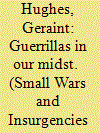

|
|
|
|
|
| Summary/Abstract |
Over the past two decades the historical record of Britain’s wars against a series of insurgencies has experienced a fundamental academic re-assessment, challenging established beliefs about how the British state and its institutions – in particular the British Army – have waged counterinsurgency, and questioning traditional presumptions that Britain fought its insurgent enemies according to a doctrine guided by ‘hearts and minds’ and ‘minimum force’. This article shows that hints about the murky reality behind the ‘British way in counterinsurgency’ can be seen in novels published during the post-war era, some of which used recent conflicts as their subject matter, others of which referred tangentially to previous wars. Not only were these best-selling books with an international audience, but these authors had experience with Britain’s armed forces and intelligence services, and were either directly involved in counterinsurgency conflicts, or their works indicated insight and knowledge about them. Their books provided fictional illustrations of many of the themes – coercive tactics against civilians, special operations against insurgents, inter-departmental disputes, the lack of cultural understanding, the maltreatment of detainees and the excessive use of force against suspected insurgents and civilians – that have been identified and examined by military historians and other academic specialists covering Britain and counterinsurgency.
|
|
|
|
|
|
|
|
|
|
|
|
|
|
|
|
| 2 |
ID:
190717
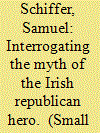

|
|
|
|
|
| Summary/Abstract |
This essay seeks to understand how since the signing of the Good Friday Agreement in 1998, marking the end of The Troubles in Northern Ireland, filmic depictions of the conflict reinterpret and interrogate the traditional role of the ‘hero’ in the Irish republican cause. In an analysis of two films released after the Good Friday Agreement, Hunger (2008) and The Wind that Shakes the Barley (2006), this essay argues that both films feature a hero-type Irish republican waging a brave-but-futile campaign against British oppression, but critique the myth of the Irish republican hero by severing the cycle of mythical violence by sowing doubt in the hero myth that serves as its base. This essay suggests that film is a low-stakes arena for the interrogation of volatile narratives that plays an important role in the reconceptualization of a conflict and, maybe even, its resolution.
|
|
|
|
|
|
|
|
|
|
|
|
|
|
|
|
| 3 |
ID:
190721
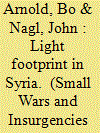

|
|
|
|
|
| Summary/Abstract |
Special Operations Forces (SOF) played an important role in defeating the Islamic State (ISIS) physical caliphate in Syria. Acting as a force multiplier, SOF successfully mobilized, armed, supplied, and directed an indigenous guerrilla force across northern Syria against a numerically superior entrenched enemy. This effort was underpinned by a flexible operational approach that adapted operational art to the unique characteristics of unconventional warfare. This paper provides a case study on the conflict with ISIS in Syria, focusing on the first phase of the campaign from 2014 until 2016, examining the elements of operational art which had the most significant impact on the outcome of the conflict. The application of operational art throughout the campaign sought to preserve and strengthen the friendly center of gravity – the Syrian Defense Forces, or SDF – by improving access to critical capabilities, controlling tempo, recognizing culmination criteria, and properly phasing operations and resources. SOF’s practice of sustained engagement garnered influence with the SDF and provided situational awareness to key decision makers, connecting tactics to strategy, engendering mutual trust, and allowing the agility that led to battlefield success.
|
|
|
|
|
|
|
|
|
|
|
|
|
|
|
|
| 4 |
ID:
190718
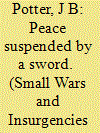

|
|
|
|
|
| Summary/Abstract |
Breaker Morant dramatizes the historical trial of a trio of Australian lieutenants who were court-martialed for executing unarmed prisoners during the Second Boer War. The midpoint turned culmination of New Australian Cinema, this film serves as an instructive case study in how soldiers justify harsh acts of violence to themselves and others. The primary mouthpieces for such explanations are the title character and the defense attorney, Major Thomas. This article argues that these justifications are rooted in factors that both men cite repeatedly – the conduct of the enemy, the chain of command, and the nature of the conflict itself.
|
|
|
|
|
|
|
|
|
|
|
|
|
|
|
|
| 5 |
ID:
190719
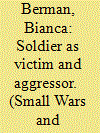

|
|
|
|
|
| Summary/Abstract |
This article examines the subversion of the hero soldier figure in three Vietnam War films from three different nations that faced defeat in Vietnam: Coppola’s Apocalypse Now, Schoendoerffer’s Dien Bien Phu, and Jeong Ji-yeong’s White Badge. A close analysis reveals that all three films undermine the image of the virtuous and powerful hero soldier through recurring stylistic elements. Apocalypse Now, through the ‘Ride of the Valkyries’ helicopter sequence – as well as the opening and ending sequences – portrays the American soldier as a barbaric aggressor. Dien Bien Phu, meanwhile, visually undermines the image of the powerful hero soldier through cinematographic techniques which portray the French soldiers in the field as small and powerless. Finally, White Badge – which, unlike the two other films, takes place in the post-war period – subverts the image of the hero soldier through its use of auditory and visual elements to portray the Korean soldier as aggressor and, first and foremost, victim. The article concludes with a discussion of how the three films influence audiences’ perceptions of those who fought in Vietnam.
|
|
|
|
|
|
|
|
|
|
|
|
|
|
|
|
| 6 |
ID:
190720


|
|
|
|
|
| Summary/Abstract |
The fascination with special forces could be ascribed to the prominence of their use in contemporary conflicts across the globe. There is, however, a paradox of employing such a highly lethal force in order to pursuit peace. With peacekeeping evolving parallel with the strategic environment, especially in Africa, the trend towards more robust interventions has become prevalent since the end of the Cold War. As such, the requirement for accurate and timely intelligence in peace missions has become crucial. Admittedly, special forces would not necessarily be the soldiers expected to wear blue berets and participate in peace missions. It may come as a surprise to the uninformed, though, to learn that special forces have indeed participated, and are still involved, in peace missions across the globe. Drawing from a case study where special forces have been involved in peace missions under the umbrella of the United Nations in the Democratic Republic of the Congo, this article investigates the utilization of special forces and the role they could play in peace missions in Africa.
|
|
|
|
|
|
|
|
|
|
|
|
|
|
|
|
|
|
|
|
|